
Renewable energy plays an important and growing role in the energy system of the European Union. The Europe 2020 strategy included a target of reaching 20% of gross final energy consumption from renewable sources by 2020, and at least 32% by 2030. The EU27 reached 22% in 2020 and 23% in 2022, up from 9.6% in 2004. These figures are based on energy use in all its forms across all three main sectors, the heating and cooling sector, the electricity sector, and the transport sector.
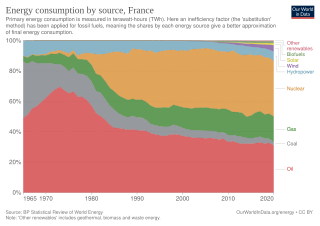
According to the International Energy Agency, France has historically generated a very low level of carbon dioxide emissions compared to other G7 economies due to its reliance on nuclear energy. Energy in France was generated from five primary sources: nuclear power, natural gas, liquid fuels, renewables and coal. In 2020, nuclear power made up the largest portion of electricity generation, at around 78%. Coal energy is declining and due to cease. Renewables accounted for 19.1% of energy consumption in 2020. France has the largest share of nuclear electricity in the world. The country is also among the world's biggest net exporters of electricity. The country is increasingly investing in renewable energy and has set a target of 32% by 2030.
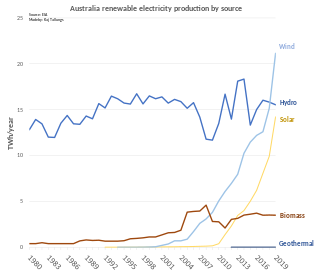
Renewable energy in Australia includes wind power, hydroelectricity, solar photovoltaics, heat pumps, geothermal, wave and solar thermal energy.

Solar power represented a very small part of electricity production in the United Kingdom until the 2010s when it increased rapidly, thanks to feed-in tariff (FIT) subsidies and the falling cost of photovoltaic (PV) panels.

In 2021 France reached a total of 18,676 megawatts (MW) installed wind power capacity placing France at that time as the world's seventh largest wind power nation by installed capacity, behind the United Kingdom and Brazil and ahead of Canada and Italy. According to the IEA the yearly wind production was 20.2 TWh in 2015, representing almost 23% of the 88.4 TWh from renewable sources in France during that year. Wind provided 4.3% of the country's electricity demand in 2015.

EDF Renewables is a wholly owned subsidiary of the French utility EDF Group, specializing in renewable energy production. As an integrated operator, the Group develops and finances the construction of renewable energy facilities, and manages operations and maintenance for its own account and for third parties.
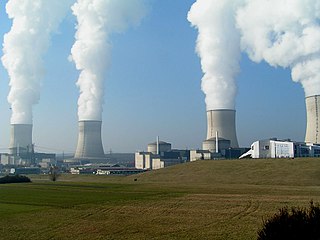
The electricity sector in France is dominated by its nuclear power, which accounted for 71.7% of total production in 2018, while renewables and fossil fuels accounted for 21.3% and 7.1%, respectively. France has the largest share of nuclear electricity in the world, and together with renewable energy supplies, this has helped its grid achieve very low carbon intensity.

Energy in the Netherlands describes energy and electricity production, consumption and import in the Netherlands. Electricity sector in the Netherlands is the main article of electricity in the Netherlands.
Solar power in France including overseas territories reached an installed capacity figure of 11.2 GW in 2020, and rose further to 17.1 GW at the end of 2022. Government plans announced in 2022 foresee solar PV capacity in France rising to 100 GW by 2050.

Solar power generated 12% of Bulgaria’s electricity in 2023.
Under its commitment to the EU renewable energy directive of 2009, France has a target of producing 23% of its total energy needs from renewable energy by 2020. This figure breaks down to renewable energy providing 33% of energy used in the heating and cooling sector, 27% of the electricity sector and 10.5% in the transport sector. By the end of 2014, 14.3% of France's total energy requirements came from renewable energy, a rise from 9.6% in 2005.
Renewable energy in Greece accounted for 29 percent of its electricity from renewable sources in 2021. By 2030, renewables are expected to have a capacity of 28GW, and exceed 61 percent of Greece's electricity consumption. This is a significant increase from 8% of the country's total energy consumption in 2008. By 2022, Greece occasionally reached 100% renewables for a few hours. The target for 2050 is a capacity of 65GW.

Renewables supply a quarter of energy in Turkey, including heat and electricity. Some houses have rooftop solar water heating, and hot water from underground warms many spas and greenhouses. In parts of the west hot rocks are shallow enough to generate electricity as well as heat. Wind turbines, also mainly near western cities and industry, generate a tenth of Turkey’s electricity. Hydropower, mostly from dams in the east, is the only modern renewable energy which is fully exploited. Hydropower averages about a fifth of the country's electricity, but much less in drought years. Apart from wind and hydro, other renewables; such as geothermal, solar and biogas; together generated almost a tenth of Turkey’s electricity in 2022. Türkiye has ranked 5th in Europe and 12th in the world in terms of installed capacity in renewable energy. The share of renewables in Türkiye’s installed power reached to 54% at the end of 2022.
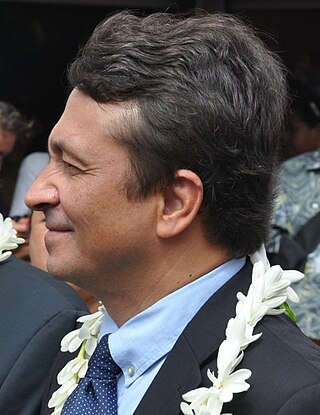
Nuihau Laurey is a French Polynesian politician and former Cabinet Minister. He was vice-president of French Polynesia from 2014–2017 and one of the two senators for French Polynesia from 2015 to 2020. He was acting president of French Polynesia in 2014 between Gaston Flosse and Édouard Fritch's presidencies.
Masen, the Moroccan Agency for Sustainable Energy, is a privately owned Moroccan company with public funding. It was created in 2010 to lead the Moroccan solar project to generate electricity from solar power by installing a minimum capacity of 2,000 MW by 2020.
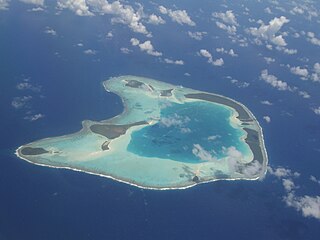
The Brando is a private resort on the Society Islands' Tetiꞌaroa atoll in French Polynesia. It serves as a regulated airstrip, research facility, eco-resort and spa on the Motu of Onetahi. It consists of 80 staff and facilities management personnel. The atoll's inside on which The Brando is located is on a 99-year lease contracted by Marlon Brando.

The energy sector in Mayotte is mainly oriented towards the consumption of electricity based on fossil fuels; renewable energies are currently underdeveloped for the moment, and there is no export of fossil fuels.

Louis Boisgibault is a French higher education director, corporate director, professor, researcher and author known for his publications on energy transition in the EMEA Region. He works as director of development and cooperations, full-time faculty member, at North American Private University in Sfax, Tunisia.
Valentina Hina Cross is a French Polynesian politician and Member of the Assembly of French Polynesia. From 2008 to 2014 she served as mayor of Teva I Uta. She is a member of Tavini Huiraatira. She is the daughter of former Assembly president Milou Ebb.
Électricité de Tahiti is an electricity company which holds the public concession for the generation and distribution of electricity in French Polynesia. In 2022 it was ranked as the largest company in French Polynesia by turnover. It is 70% owned by the Engie group, with the Société Monégasque de l'Electricité et du Gaz, itself a subsidiary of Engie, holding a further 21%.














